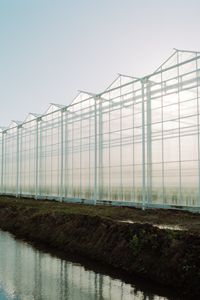Heating a Greenhouse
Greenhouses create a sheltered environment for plants by using solar radiation to trap heat. This system of heating and circulating air helps to create an artificial environment in a greenhouse that can sustain plants when the outdoor temperature is too cool or variable. Heat enters the greenhouse through its covering of glass or plastic and starts to warm the objects, soil and plants inside. The warmed air near the soil begins to rise and is immediately replaced with cooler surrounding air that starts to heat up. This cycle raises the temperature inside the greenhouse more rapidly than the air outside, creating a sheltered, warmer microclimate.
In temperate climates, the sun might do all the heating in the greenhouse, but where the temperatures plummet, artificial heat may be necessary to maintain temperatures above freezing. Where some greenhouses have access to central heat from the main building, others have to rely on natural or bottled gas, heating coils or heating fans. These will usually work in conjunction with a thermostat. Because heat is one of the biggest expenses of keeping a greenhouse, other sources of energy are always being explored, like the use of solar batteries or animals as heat sources.
Advertisement
There are also other processes acting on the air inside a greenhouse. The sun's energy can travel through greenhouse glass easily, but the radiation emitted by the plants and soil that have absorbed the heat doesn't get out as easily, helping to trap heat inside.
This makes it possible to keep a greenhouse warm, but it also can cause problems with overheating. In order to keep plants from getting too hot, some method of heat control is necessary. Vents that allow the lighter, hotter air to exit the greenhouse near the roof and cooler air to enter closer to ground level act as air conditioning. Proper ventilation keeps the air in a greenhouse circulating. This helps maintain a stable temperature and also cycles the carbon dioxide (CO2) that plants need for photosynthesis [source: Martell]. Generally, greenhouses have at least two vents, one on or near the roof and one on the lower half of the structure. Mechanical ventilators can also help maintain good airflow and heat control by opening and closing the vents automatically when the temperature in the greenhouse changes.
And of course, all of the plants inside a greenhouse need some sort of water. Whether you use a garden hose, watering can or a sophisticated automated system with water sensors, water is essential in a greenhouse. Because watering is the most time-consuming greenhouse chore, the use of some type of automated system, like wicking, capillary matting or drip irrigation can make the process more consistent and reliable. Even if feeding water directly to the greenhouse via an underground pipe isn't possible, placing a greenhouse near water is a practical necessity.
In the next section, we'll explore different types of greenhouses and the relationship they have to the plants they contain.
